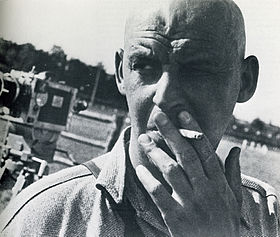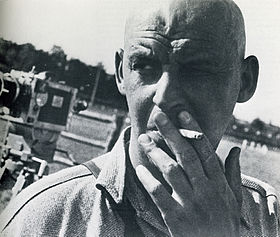Rodchenko, an avant-gardist’s avant-gardist if ever there was one, could easily have inspired the Minimalist LeWitt. Rodchenko’s ideas, starting in the thin air of abstract thought, precipitated forms about as vague as a slap. Almost any work by him, be it painting or photograph or interior design or advertisement, zings with material and intellectual clarity — never mind that its premises are indeed irrational and some of its implications may be morally grotesque.
This visually exhilarating show sickens me with its tainted glories and anguishing ironies. How does one assess Rodchenko? By what measure? According to whom? He was among the most zealous of the Russian avant-gardists who identified totally with the policies of triumphant Communism. The policies were horrible from the start. The artists were perhaps understandably blinded to the truth by naïveté and initial privilege.
But Rodchenko, as the nightmare unfolded, proved himself sincere. He capitulated abjectly to each mad turn of Party ideology and willingly abetted epic criminality. He took thousands of propaganda photographs at the White Sea Canal project, gazing through his camera at a slow-motion massacre of 200,000 persons and praising Stalin with every frame. By the mid 1930s, his photographic work was hardly distinguishable from that of his German contemporary Leni Riefenstahl. Both celebrated the totalitarian sublime.
Rodchenko’s reward? Official contempt and professional oblivion. But, after all, he got to live out his years peacefully with his wife and fellow avant-gardist Varvara Stepanova in their Moscow apartment, allocated to them in 1922. Having dashingly declared painting dead in 1921, the marginalized Rodchenko painted pictures of sad clowns. Maybe this passes for a Soviet happy ending. He died in 1956, Stepanova two years later.
To value Rodchenko as his genius merits, I must set his politics aside. This is easier than it sounds. I believe that even the deepest political conviction is shallow relative to the gut sources of art — a belief shared by shrewd tyrants like Stalin, who despised artists pretty much per se. Whatever artists may think they think, they bow down in secret to renegade gods. They can’t help it even if, like Rodchenko, they police their own souls on the tyrant’s behalf.
A born joiner of groups and extrapolator of ideas that were in the air, Rodchenko hit Moscow a bit late, in 1915. The avant-garde, long nourished by European influences, had come into its own during a year of being sealed off from the West by war. Malevich and Tatlin led. Kandinsky and Chagall thrived. Amazing talents (many of them women) sprang up in bunches. Movements flashed by. Then came the revolution, which the artists greeted as if it had been their idea.
Rodchenko was the Lucky Lindy of a high-flying scene that was enabled and protected by the liberal Anatoly Lunacharsky, the first People’s Commissar of Enlightenment. On countless committees, Rodchenko helped vest the avant-garde with institutional clout: a pocket dictatorship of the far-out. Meanwhile, he put his stamp on esthetic programs that, with Constructivism, suppressed all trace of traditional composition in painting (goodbye, Malevich) and then, as Productivism, renounced studio art in toto.
Like Tatlin — and unlike the profoundly mystical Malevich — Rodchenko was an artist as engineer, blazing theoretical trails to practical goals. Was his stance a trifle mystical itself? It was, in a Marxist vein: presuming, against any and all evidence to the contrary, a oneness of formal logic and history, materialism and human happiness. Though perhaps regrettably messy at first, everything would come beautifully clear in the long run.
Rodchenko’s esthetic was a cult of process that ran cold and hot. Coldly, he reduced pictorial art to analytical demonstrations of line, shape, surface, and color. Hotly, he synthesized these elements with rhythmic flair in service to public design and display. His work’s central symbol is its dominant device: the diagonal. At MoMA, look for horizontal and vertical lines. There practically aren’t any.
In the West, Piet Mondrian was shunning the diagonal, which in his vision of universal stability could represent only accidental, anecdotal states. Rodchenko positively sang the accidental and anecdotal, celebrating a world of speed and optimistic chaos. As a photographer, he addressed reality from every angle except head on. His p.o.v. could be anywhere except on the ground. He built his pictures like truss bridges, crisscross fashion, with strength doubled and trebled by structural tensions.
More than one major artist has been a gladly self-deluding courtesan to power. Energy is art’s criterion, and nothing may generate more pep than an onset of tyranny. The Russian avant-garde will always intoxicate young artists of radical temperament, no matter how much murder and misery get entered into the historical account of Communism. Love artists, as they should be loved. There is rarely a defensible reason to trust them.
PETER SCHJELDAHL is art critic for the Village Voice, where this article first appeared.
Another biography of Alexander Mihailovich Rodchenko
Portfolio of Rodchenko’s work at photoarts.com
Constructivists Books
The Museum of Modern Art – Exhibition of Rodchenko’s work
 Gyro’s T-shirt designs page
Gyro’s T-shirt designs page مقالة مفصلة: عمارة بنائية
مقالة مفصلة: عمارة بنائية









